So many festive traditions! No matter how styles change in home fashions, some holiday decorations still remain the same. It is those wonderful feelings we get from that decor in our homes that make us feel so warm and fuzzy inside. So how did so many of the classic Christmas decor come about?
Tinsel:
Tinsel originated in Germany in the early1600s but it was a far cry from the shiny plastic tinsel we use today — back then it was shredded silver. Real silver.
Tinsel makers of the day would hammer the silver until it was thin, then cut it into strips. Nobody seems to have recorded the name of the clever person who invented tinsel but it was so popular, machines began making the stuff to keep up with demand.
Eventually people realized the smoke from Christmas candles caused the tinsel to turn black, so later versions were made with tin and lead. That version proved to be too heavy for a Christmas tree, so the Brits took over and came up with the light silver sparkly tinsel we enjoy today.

Baubles:
Once again the Germans stepped up in the decoration invention department. Baubles were first invented in Lauscha, by local man Hans Greiner, who first manufactured them in the late 1840s. The first baubles were fruit and nut shaped glass, eventually turning into a more spherical shape.
Britain’s Queen Victoria was said to be quite taken with the tradition of baubles and brought them from Germany to Europe in the mid to late 1800s.
American retailer F.W. Woolworth made his fortune by importing baubles into the country in 1880. By 1890, he was reportedly selling $25 million worth a year.
At first, baubles were only for wealthy people as they were hand-crafted and made of glass. But it wasn’t long before a plastic version was made, allowing cheaper manufacturing and affordability for everyone.
In 1973, Hallmark introduced their “Keepsake” ornaments, which afforded these decorations collectible value. The first collection consisted of glass baubles and little yarn figures, and each successive line of limited-edition ornaments has been unique to the year.
In the UK, Queen Victoria declared that it’s bad luck to keep your Christmas decorations up after the 12th day of Christmas, on the 5th of January. Many people continue this tradition — and it’s a nifty way to force family members to start packing up decorations and putting them away for next year.

Christmas trees:
We call them “Christmas” trees, but the decorative evergreen long pre-dates the celebration of Christmas. Evidence suggests that the practice of adorning the home with evergreen boughs during the winter solstice dates as far back as the ancient Egyptians. The comforting presence of evergreen life offered hope during winter’s cold days and long nights, serving a similar purpose in the various pagan winter solstice rituals of the Druids, Romans, and Vikings.
Nobody seems to know exactly when fir trees were first used as Christmas trees but the general consensus is that it began about 1000 years ago in Northern Europe. Many early Christmas Trees seem to have been hung upside down from the ceiling using chains (hung from chandeliers or lighting hooks).
The ‘modern’ Christmas tree tradition is thought to have originated in 16th century Germany, where small evergreen trees were decorated with the likes of candles, apples, nuts, and berries as “Paradise trees” in church plays.
In parts of Northern Europe some other early Christmas Trees included cherry or hawthorn plants. They’d be re-planted into pots in the hope they’d flower at Christmas time. For those who couldn’t afford a plant, a substitute was to make a pyramid of wood, which were then decorated to look like a tree with paper, apples and candles. The modern version is synthetic but plenty of people still use the real deal.
Christmas lights:
In Victorian times, the tree would have been decorated with candles to represent stars. In many parts of Europe, candles are still used to decorate Christmas trees.
American insurance companies in the U.S. tried to get a law passed so that candles would be banned from use on Christmas trees because of the many fires they’d caused. In 1895, an American man, Ralph Morris, was concerned about the fire hazard of candles and Christmas trees so he invented the first electric Christmas lights, which are similar to the ones in use today.

Sources:
The History Of Christmas Decorations, huffpost.com By Libby-Jane Charleston
A Brief History Of The Christmas Ornament, theculturetrip.com by Rachel Gould
About Tran + Thomas
Built on the foundation of a 30-year, family-owned Interior Design business, Jill Tran and Carmen Thomas opened Tran + Thomas Design Studio in 2011 bringing a combined 36 years of experience to their projects. They work on both residential and commercial projects across several styles. Interested in their services? Call (913) 268-9595 or schedule a consultation below.
